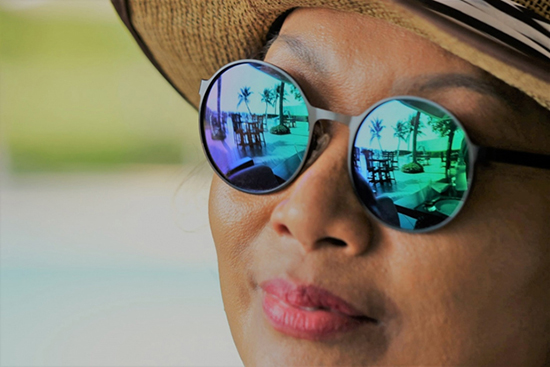Let’s start by talking about the electromagnetic spectrum. The spectrum consists of all the types of electromagnetic radiation, arranged according to frequency and wavelength. There’s very high energy with short wavelengths which include gamma rays, used by PET scanners with a wavelength below 10 picometres, (one-trillionth of a meter) x-rays, and ultraviolet rays followed by visible light which the human eye detects. The waves move from higher energy with shorter wavelengths to longer ones with lower energy. The lower energy and longer wavelengths include radio waves, microwaves, and infrared (night vision goggles).
Ultraviolet rays are shorter than the visible spectrum and are classified as UV-A, UV-B, and UV-C. UV-A rays have longer wavelengths followed by UV-B and UV-C which have the shortest wavelengths. UV-C and some UV-B rays are absorbed by the earth's ozone layer.
 |
There’s an increased risk of developing macular degeneration and cataracts with exposure to ultraviolet radiation. Additionally, long-term exposure to ultraviolet light can cause pinguecula and pterygium. Pinguecula are yellowish brown sub-conjunctival elevations usually located near the cornea at the 3 or 9 o’clock position. A pterygium is an abnormal wedge-shaped growth that originates on the bulbar conjunctiva and extends onto the cornea.
It is our role and responsibility as opticians to provide the information about lenses that can protect the eyes from harmful ultraviolet rays. If one pair is the only option, suggest photochromic lenses which darken by the amount of UV light exposure. Photochromic lenses have UV dyes in their monomers, separate from the photochromic dyes, that provide 100% UV protection. The lenses darken and provide protection even on cloudy days.
Some possibilities for your patients include:
Photochromic lenses: These UV light activated lenses come in a variety of colors with or without mirrors. The most popular colors are gray and brown, but most premium sunglass manufacturers now offer color enhancing lenses in a variety of tint colors.
Polarized lenses: These lenses do a tremendous job of improving clarity by blocking out light in the horizontal plane, while light rays in the vertical plane transmit through the lens. Glare from flat shiny surfaces like a car hood or dashboard, steamy hot pavement on a summer day, or the horizontal glare from a lake or pond is blocked. Fishermen and boaters especially enjoy polarized sunglasses.
Wraparound sunglasses: Some patients need the extra protection of a wraparound frame. Not all prescriptions are appropriate for a wrap frame, though. Opticians who understand lens technology and prescriptions can determine whether the frame and the Rx are a good fit. Freeform technology has expanded the range of prescriptions that can be made in wrap frames. If you’re not comfortable with this topic, start by talking with your lab or an optical mentor.
All sunwear must have 100% UV protection. While most optical offices do not have accessories such as sunscreen and wide-brimmed hats, we would be remiss not to mention them during the conversation about eye safety and ultraviolet protection.
How can we make this happen? One way is to recommend sunglass protection to patients and explain the reason it is so important. Utilizing second pair discounts must be part of our vernacular. If your office or company does not offer patients a second pair discount, present that to the management. And if you are the management, bring that offer on. Selling a second pair in either photochromatic or polarized is good for your bottom line and for your patients’ eyes.
Learn how to improve the visual experience for those with light sensitivity indoors and outdoors with our CE, Beautiful and Effortless Light Protection for Everyone, at 2020mag.com/ce. This course is free, supported by an educational grant from Transitions Optical.













